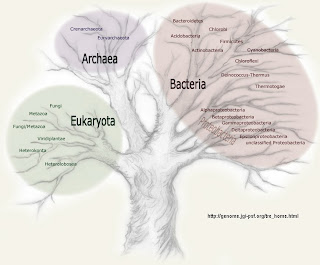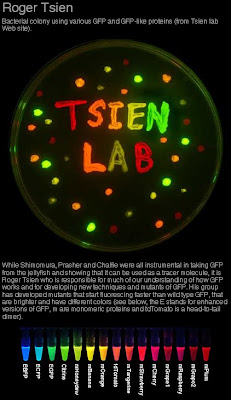 The second day began bright and early with a talk by Jeffrey Lawrence, professor of biology at the University of Pittsburgh, Pittsburgh (PA, USA).
The second day began bright and early with a talk by Jeffrey Lawrence, professor of biology at the University of Pittsburgh, Pittsburgh (PA, USA). The title of his talk, Fragmented speciation in bacteria: The failure of the coalescent model doesn't really reflect its significance. Jeff showed us his careful analysis of speciation in bacteria focusing on a small clade of bacteria including Escherichia coli, and its closest relatives, Citrobacter kosteri, Salmonella enterica, Enterobacter sp., Klebsiella pneumonia etc.
When "speciation" occurs in bacteria there is considerable lateral gene exchange that obscures the actual relationship. What this means is that there really is no single common ancestor of most pairs of species and, given that it is almost impossible to define a species in the first place, a single phylogenetic tree of organisms is not a correct depiction of the tree of life.
Imagine a situation where our human ancestor was hanging out with the ancestors of gorillas and chimpanzees and a lot of gorilla ancestral genes made it into our genome. We wouldn't be able to depict the true representation of our evolution by just showing a simple bifurcating tree where we are closest to chimpanzees and more distant from gorillas. This treelike representation would ignore the transfer of genes between our ancestor and that of gorillas. You need a net or a web to show the actual path of descent. That's the situation in bacteria, as we saw clearly in the presentation.
But the failure of genomes to coalesce to a single ancestor doesn't make the whole exercise useless. It's still possible to say that Escherichia coli, Citrobacter kosteri and Salmonella enterica are more closely related to each other that any of them are to Klebsiella pneumoniae. Jeff gave us some estimates of the frequency of lateral gene transfer but I didn't write them down. The general consensus at the meeting is that DNA from another species is incorporated at the rate of once every few million years. This is enough to seriously compromise a treelike phylogeny.
Greg Morgan is a philosopher who is currently at a college in New Jersey. He gave the second talk. His title was Defining biodiversity in a world with horizontal gene transfer. He was mainly critiquing a book by the philosophers Maclaurin and Sterelney on biodiversity. Their concept of a species doesn't take lateral gene transfer into account and it doesn't really pay attention to the microbial world and the definition of species. Greg emphasized that there are many ways to define biodiversity and it makes a difference if you are interested in preserving biodiversity.
Laura Franklin-Hall is a philosopher at New York University in New York (NY, USA).Her presentation was an attempt to root for the underdog by defending trees: Scientific models and the history of life: Deep disagreement or mere misunderstanding?
I wish I had time to explain her description of scientific models and how they work but I didn't take enough notes and, besides, I'm still digesting the information. The idea is that no model is perfect—they all suffer from various weaknesses—and we shouldn't necessarily opt for the model that incorporates the most detail. In other words, while a web or a net may be a more accurate description of descent with modification, there's still a lot to be said for a tree if it represents some underlying, but partial, truth.
Maureen O'Malley is a philosopher at the University of Exeter and a former colleague of Ford Doolittle's. She is one of the behind-the-scenes organizers of the meeting. Her talk was on The philosophy of evolution, Ernst Mayr and the tree of life. She gave a really interesting summary of Mayr's views on evolution—a view which obviously didn't consider microbes and didn't concentrate on genes ("beanbag genetics").
I think its fair to say that most evolutionary biologists in the room found it interesting to review the history of Mayr's thoughts, but that's all it was; history. The philosophers, on the other hand, were much more attentive. Apparently Mayr is thought of as one of the founding fathers of the philosophy of biology and an "attack" on Mayr is close to blasphemy. That's shocking to me and it suggests that philosophers of biology are very much out of touch with modern evolutionary biology. This observation is consistent with some of the things that went on at this meeting although I hasten to add that most of the philosophers here seem to have a much more modern perspective. They weren't the least bit unhappy to see Mayr dethroned.
(I gather that photographs of Maureen are unusual. That's why the group photo at the top of the page is so important. She's right there in the second row.)
Eric Bapteste is a philosopher at IHPST in Paris (France). He told us how important it is to incorporate Lateral thinking about trees into our view of evolution. By "lateral thinking" he means the idea that genes can be inherited horizontally and not just vertically.
Lisa Gannet is a philosopher at St. Mary's University here in Halifax (NS, Canada). Her talk was on the difficulties in reconstructing the history of human populations and the various ways of representing it. Much of her talk was peppered with references to racism and it became apparent that she is very concerned about whether a tree of humans populations might support racism. After her talk I asked her about this and it turns out she is one of those people who don't think that human races exist.
The next talk was by James Mallet, a biologist at the Galton Laboratory, University College London, London (UK). The title of his talk certainly got everyone's attention: Was Darwin wrong about the nature of species and speciation?. Jim began by quoting Ernst Mayr, who in several papers, made the point that Darwin was wrong about speciation. Mayr quoted directly from Darwin's works to support the idea that he (Darwin) had an incorrect view of speciation.
Jim demolished that idea by showing that Mayr was as guilty of quote-mining as our typical creationist friends. It turns out that Darwin's ideas on species and speciation were far more accurate than Mayr was willing to admit and it's time we acknowledged that. Jim went on to illustrate real examples of speciation by looking at various races and varieties of butterflies in Venezuela. Just as Darwin imagined, there's a smooth continuum from varieties, races, and subspecies to real speciation events and it's often difficult to distinguish between races and species. Many species interbreed to form hybrids, as he showed using his data, but the hybrids might be quite rare indicating that gene flow between the species is almost nonexistent.
The last talk was by Richard (Dick) Burian, a philosopher at Virgina Tech in Blacksburg (VA, USA). He spoke about "Some conceptual issues deriving from the challenges to tree thinking. The emphasis was on identifying the "process" that can explain the "pattern" of evolution. This becomes difficult in the face of chimeras and symbiosis. Dick tried to establish the criteria that these processes had to fulfill in order to be legitimate contenders in the explanation of evolution. One of the criteria was selection so I asked him whether random genetic drift was a process that could be used to explain the pattern of evolution. The answer was "no." After the talk we had a discussion about this and we both agreed to think about it.
We all went off to dinner at The Cellar restaurant. Much alcohol was consumed and this contributed greatly to the discussions. As usual. we went home satisfied that we have solved most of the problems and woke up forgetting the solutions. We'll try again tonight. I'm more convinced than ever that this is the best meeting I've ever attended. I'm learning things at such a furious rate that my brain is beginning to feel the pain.













